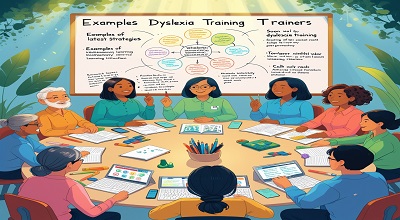Dyslexia Training for Teachers
Dyslexia Training for Teachers: Dyslexia is a specific learning difficulty that affects reading, spelling, and writing. It is a neurological condition that impacts the way the brain processes written and spoken language. Understanding and supporting students with dyslexia is crucial for educators to ensure equitable learning opportunities for all students.
Understanding Dyslexia Training for Teachers
Dyslexia is characterised by difficulties with accurate and/or fluent word recognition and by poor spelling and decoding abilities. These difficulties typically result from a deficit in the phonological component of language that is often unexpected in other cognitive abilities and the provision of effective classroom instruction.
Importance of Teacher Training
Effective teacher training is essential in equipping educators with the knowledge and skills to support students with dyslexia. Training programs should focus on:
- Identification of Dyslexia: Recognizing early signs and symptoms.
- Understanding the Neurobiological Basis: Gaining insight into how dyslexia affects the brain.
- Evidence-Based Instructional Strategies: Implementing structured literacy approaches.
- Classroom Accommodations: Modifying teaching methods to support diverse learners.
Latest Training Programs and Resources
- Made By Dyslexia Training Made By Dyslexia offers a comprehensive training program for educators, focusing on understanding how dyslexic students think and providing practical strategies for support. Their Level 1 course covers dyslexia awareness, while Level 2 delves into teaching methodologies. These courses are designed to be accessible and informative for teachers at all levels.
- Dyslexia Training Institute The Dyslexia Training Institute provides professional development opportunities for educators, including online courses and certification programs. Their training covers topics such as structured literacy, dyslexia advocacy, and effective teaching strategies. The institute also offers custom training tailored to the needs of individual schools or districts.
- Scottish Rite for Children Scottish Rite for Children offers a two-week training program for certified teachers, combining in-person instruction with coaching and support. Their program emphasizes structured dyslexia intervention and aims to reduce teacher preparation time while maintaining high-quality instruction.
Structured Literacy Approaches
Structured literacy is an approach to teaching reading and writing that is explicit, systematic, and sequential. It is particularly effective for students with dyslexia. Key components include:
- Phonology: Understanding and manipulating sounds in spoken language.
- Sound-Symbol Association: Connecting sounds to letters or groups of letters.
- Syllable Instruction: Teaching the six syllable types and how to divide words into syllables.
- Morphology: Understanding the structure of words, including prefixes, suffixes, and root words.
- Syntax: Understanding sentence structure.
- Semantics: Understanding the meaning of words and sentences.
Classroom Strategies and Examples
Implementing effective strategies in the classroom can significantly support students with dyslexia:
- Multisensory Instruction: Engage multiple senses (sight, hearing, touch) to reinforce learning. For example, using sandpaper letters for tactile tracing while saying the sound aloud.
- Use of Technology: Incorporate tools like text-to-speech software and audiobooks to support reading.
- Graphic Organizers: Utilize visual aids to help students organize information and ideas.
- Flexible Grouping: Group students based on their learning needs rather than ability levels.
- Positive Reinforcement: Provide regular praise and encouragement to build confidence.
Assessment and Monitoring
Regular assessment is crucial to monitor the progress of students with dyslexia:
- Screening Tools: Use tools like the Dyslexia Screening Instrument to identify at-risk students.
- Progress Monitoring: Implement regular assessments to track student progress and adjust instruction accordingly.
- Data Analysis: Analyze assessment data to inform instructional decisions and interventions.
Collaboration and Support
Collaboration among educators, parents, and specialists is vital:
- Individualized Education Plans (IEPs): Develop and implement IEPs tailored to the needs of students with dyslexia.
- Professional Learning Communities: Engage in ongoing professional development and collaboration with colleagues.
- Parent Involvement: Maintain open communication with parents to support learning at home.
Conclusion
Dyslexia Training for Teachers is a complex condition that requires a comprehensive and informed approach to support affected students. Through effective teacher training, structured literacy instruction, and collaborative efforts, educators can make a significant difference in the lives of students with dyslexia.
Frequently Asked Questions
Why is teacher training important for supporting students with dyslexia?
Teacher training is essential because it equips educators with the knowledge and skills to identify and support students with dyslexia. Well-trained teachers can implement effective instructional strategies and accommodations to meet the needs of these students.
What is dyslexia?
Dyslexia is a specific learning difficulty that affects reading, spelling, and writing. It is characterized by difficulties with accurate and/or fluent word recognition and by poor spelling and decoding abilities.
How can teachers identify dyslexia in students?
Teachers can identify potential signs of dyslexia by observing difficulties in reading fluency, spelling, and writing, as well as challenges in phonological processing. Early identification is crucial for effective intervention.
What are structured literacy approaches?
Structured literacy approaches are explicit, systematic, and sequential methods of teaching reading and writing. They include components such as phonology, sound-symbol association, syllable instruction, morphology, syntax, and semantics.
How can technology support students with dyslexia?
Technology can support students with dyslexia by providing tools like text-to-speech software, audiobooks, and word processors with spell check features. These tools can aid in reading and writing tasks.
Free Here: ZombieBooth 2
